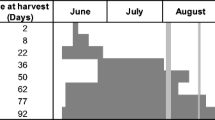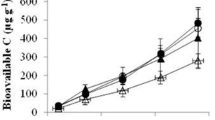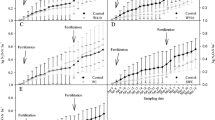Abstract
Maintaining nutrient availability in organic orchards presents challenges. Diverse litter sources may increase nutrient cycling and the efficiency by which microbes utilize carbon (C). Two tree-row treatments: ‘straw-mulch’ (Triticum aestivum L.) and ‘living-mulch’ (Lobularia maritima (L.) Desv.), and two alleyway groundcovers: ‘grass’ (Festuca rubra with Lolium perenne L.) and a legume, ‘Birdsfoot trefoil’ (Lotus corniculatus L.) were compared to an industry standard, tillage with a grass alleyway. Tree-row deposited trefoil biomass contributed 0.2 kg additional total nitrogen (N) per tree annually. Soil from tree-rows with trefoil alleyways had 23% greater organic C (+ 3.1 g kg−1), 17% greater total N (+ 0.3 g kg−1), up to 53% greater microbial biomass (+ 204 mg CO2–C kg−1), 32, 34 and 31% greater dehydrogenase (+ 2.3 µg TPF g−1), alkaline (+ 55.9 µg p-nitrophenol g−1) and acid (+ 106.7 µg p-nitrophenol g−1) phosphomonoesterase enzyme activity, 62% greater soil NO3−N (+ 2.05 µg NO3−1 g−1), and 51% higher nitrification rates (+ 0.22 µg NO2−–N + NO3−–N g−1 soil h−1) than tree-row soils adjacent to grass alleyways. Straw-mulch and living-mulch soils did not differ. Metabolic CO2 quotient (qCO2) values were lowest in trefoil (0.0032) and living-mulch with grass treatments (0.0036), indicating greater microbial growth efficiency. Tillage and straw-mulch with grass alleyway treatments had the highest qCO2 (0.0053 and 0.0048) and the lowest microbial biomass (246.3 and 297.6 mg CO2–C kg−1 soil). Higher potential biochemical activity, and total C and N, suggests orchards with trefoil alleyways cut and deposited into tree-rows, enhances soil organic matter and promotes balanced nutrient cycling and retentive processes.




Similar content being viewed by others
References
Alston D, Reding M, Murray M (2010) Cat-facing insects. Utah State University Extension Publication Orchard IPM Series. https://extension.usu.edu/files/publications/factsheet/cat-facing.pdf. Utah State University Cooperative Extension
Anderson TH (2003) Microbial eco-physiological indicators to asses soil quality. Agric Ecosyst Environ Biot Indic Biodivers Sustain Agric 98:285–293. https://doi.org/10.1016/S0167-8809(03)00088-4
Anderson TH, Domsch KH (1978) Physiological method for quantitative measurement of microbial biomass. Soil Biol Biochem 10:215–221
Anderson TH, Domsch KH (1989) Ratios of microbial biomass carbon to total organic-carbon in arable soils. Soil Biol Biochem 21:471–479
Anderson TH, Domsch KH (1990) Applications of ecophysiological quotients (QCO2 and QD) on microbial biomasses from soils of different cropping histories. Soil Biol Biochem 22:251–255
Anderson TH, Domsch KH (1993) The metabolic quotient for CO2 (QCO2) as a specific activity parameter. Soil Biol Biochem 25:393–395
Atkinson D (1983) The growth, activity and distribution of the fruit tree root system. In: Atkinson D, et al. (eds) Tree root systems and their mycorrhizas: developments in plant and soil sciences. Springer, Dordrecht, pp 23–35
Atucha A, Merwin IA, Brown MG (2011) Long-term effects of four groundcover management systems in an apple orchard. HortScience 46:1176–1183
Bardgett RD, Shine A (1999) Linkages between plant litter diversity, soil microbial biomass and ecosystem function in temperate grasslands. Soil Biol Biochem 31:317–321
Brady NC, Weil R (2002) Soil organic matter. In: Magdof F, et al. (eds) The nature and properties of soils, 13th edn. Pearson Education, Upper Saddle River, pp 498–542
Bünemann EK, Bongiorno G, Bai Z, Creamer RE, De Deyn G, de Goede R, Fleskens L, Geissen V, Kuyper T W, Mäder P, Pulleman M, Sukkel W, van Groenigen JW, Brussaard L (2018) Soil quality—a critical review. Soil Biol Biochem 120:105–125
Cambardella CA, Elliott ET (1992) Particulate soil organic-matter changes across a grassland cultivation sequence. Soil Sci Soc Am J 56:777
Cookson WR, Murphy DV, Roper M (2008) Characterizing the relationships between soil organic matter components and microbial function and composition along a tillage disturbance gradient. Soil Biol Biochem 40:763–777
Crews TE, Peoples MB (2004) Legume versus fertilizer sources of nitrogen: ecological tradeoffs and human needs. Agric Ecosyst Environ 102:279–297
Crews TE, Peoples MB (2005) Can the synchrony of nitrogen supply and crop demand be improved in legume and fertilizer-based agroecosystems? a review. Nutr Cycl Agroecosyst 72:101–120
de Graaff M-A, Classen AT, Castro HF, Schadt CW (2010) Labile soil carbon inputs mediate the soil microbial community composition and plant residue decomposition rates. New Phytol 188:1055–1064
Dehlin H, Nilsson MC, Wardle DA (2006) Aboveground and belowground responses to quality and heterogeneity of organic inputs to the boreal forest. Oecologia 150:108–118
Deng SP, Tabatabai MA (1997) Effect of tillage and residue management on enzyme activities in soils: III phosphatases and arylsulfatase. Biol Fertil Soils 24:141–146
Deng SP, Tabatabai MA (2000) Effect of cropping systems on nitrogen mineralization in soils. Biol Fertil Soils 31:211–218
Dick WA (1984) Influence of long-term tillage and crop-rotation combinations on soil enzyme activities. Soil Sci Soc Am J 48:569–574
Dick RP (1992) A review: long-term effects of agricultural systems on soil biochemical and microbial parameters. Agric Ecosyst Environ 40:25–36
Doran JW, Parkin TB (1996) Defining and assessing soil quality. In: Doran JW, Jones AJ (eds) Methods for assessing soil quality. SSSA Special Publication, Soil Science Society of America, Madison, pp 3–22
Doran JW, Zeiss MR (2000) Soil health and sustainability: managing the biotic component of soil quality. Appl Soil Ecol 15(1):3–11
Forge TA, Hogue E, Neilsen G, Neilsen D (2003) Effects of organic mulches on soil microfauna in the root zone of apple: implications for nutrient fluxes and functional diversity of the soil food web. Appl Soil Ecol 22:39–54
García-Ruiz R, Ochoa V, Hinojosa MB, Carreira JA (2008) Suitability of enzyme activities for the monitoring of soil quality improvement in organic agricultural systems. Spec Sect Enzym Environ III 40:2137–2145
Gavlak RG, Horneck DA, Miller RO, Kotuby-Amacher J (2003) Plant, soil, and water reference methods for the Western region. WCC-103 WREP-125, p 65
Goh KM, Tutua S (2004) Effects of organic and plant residue quality and orchard management practices on decomposition rates of residues. Commun Soil Sci Plant Anal 35:441–460
Gotaas HB (1956) Composting—sanitary disposal and reclamation of organic wastes. World Health Organ 31:44
Hart S, Nason G, Myrold D, Perry D (1994) Dynamics of gross nitrogen transformations in an old-growth forest—the carbon connection. Ecology 75:880–891
Hoagland L, Carpenter-Boggs L, Granatstein D, Mazzola M, Smith J, Peryea F, Reganold JP (2008) Orchard floor management effects on nitrogen fertility and soil biological activity in a newly established organic apple orchard. Biol Fertil Soils 45:11–18
Idowu OJ, Van Es HM, Abawi GS, Wolfe DW, Schindelbeck RR, Moebius-Clune BN, Gugino BK (2009) Use of an integrative soil health test for evaluation of soil management. Renew Agric Food Syst 24(3):214–224
Insam H, Domsch KH (1988) Relationship between soil organic carbon and microbial biomass on chronosequences of reclamation sites. Microb Ecol 15:177
Kessler J, Breman H (1991) The potential of agroforestry to increase primary production in the Sahelian and Sudanian zones of West Africa. Agrofor Syst 13:41–62
Kononova M (1961) Soil organic matter, its nature, its role in soil formation and in soil fertility. Pergamon Press, London, p 450
Lejon DPH, Sebastia J, Lamy I, Chaussod R, Ranjard L (2007) Relationships between soil organic status and microbial community density and genetic structure in two agricultural soils submitted to various types of organic management. Microb Ecol 53:650–663
McInerney B, Alvord C (2007) Assessing water supply conditions for Utah. (No 3), Intermountain West Climate Summary, p 23–24
Merwin I, Stiles W (1994) Orchard groundcover management impacts on apple tree growth and yield, and nutrient availability and uptake. J Am Soc Hortic Sci 119:209–215
Moebius-Clune BN, Stott DE, Field DJ, Morgan CLS, McBratney AB (2017) Global soil security. Springer, Cham
Mullinix K, Granatstein D (2011) Potential nitrogen contributions from legumes in Pacific Northwest Apple Orchards. Int J Fruit Sci 11:74–87
Neilsen G, Forge T, Angers D, Neilsen D, Hogue E (2014) Suitable orchard floor management strategies in organic apple orchards that augment soil organic matter and maintain tree performance. Plant Soil 378:325–335
Neumann G, Römheld V (2012) Chapter 14—Rhizosphere chemistry in relation to plant nutrition. In: Marschner P (ed) Marschner’s mineral nutrition of higher plants, 3rd edn. Academic Press, San Diego, pp 347–368
Ovalle CA, González M, Hirzel J, Pino I, del Pozo A, Urquiaga S (2008) Contribution and transfer of nitrogen from cover crops to raspberry plant using isotopic techniques with 15N. Acta Hortic ISHS 777:65–472
Ovalle C, del Pozo A, Peoples MB, Lavín A (2010) Estimating the contribution of nitrogen from legume cover crops to the nitrogen nutrition of grapevines using a 15N dilution technique. Plant Soil 334:247–259
Reeve JR, Black BL, Ransom CV, Culumber CM, Lindstrom T, Alston D, Tebeau A (2013) Developing organic stone-fruit production options for Utah and the Intermountain West United States. Acta Hortic 1001:65–72
Reeve JR, Culumber CM, Black BL, Tebeau AS, Ransom CV, Rowley MA, Alston DG, Lindstrom T (2017) Establishing peach trees for organic production in Utah and the Intermountain West. Sci Hortic 214:242–251
Reighard GL, Newall WC Jr (1993) Orchard middles and rootstock cultivar influence peach tree growth and fruiting on deep sandy soils. Acta Hortic 349:159–162
Rinot O, Levy GJ, Steinberger Y, Svoray T, Eshel G (2019) Soil health assessment: a critical review of current methodologies and a proposed new approach. Sci Total Environ 648:1484–1491
Robertson GP, Wedin D, Groffman PM, Blair JM, Holland EA, Nedelhoffer KJ, Harris D (1999) Soil carbon and nitrogen availability. Nitrogen mineralization, nitrification and soil respiration potentials. In: Robertson GP, et al. (eds) Standard soil methods for long-term ecological research. Oxford University Press, New York, pp 258–271
Rowley MA, Ransom CV, Reeve JR, Black BL (2011) Mulch and organic herbicide combinations for in-row orchard weed suppression. Int J Fruit Sci 11:316–331
Sanchez JE, Edson CE, Bird GW, Whalon ME, Wilson TC, Harwood R, Kizilkaya K, Klein W, Middleton A, Loudon TL (2003) Orchard floor and nitrogen management influences soil and water quality and tart cherry yields. J Am Soc Hortic Sci 128:277–284
Sirrine J, Letourneau DK, Shennan C, Sirrine D, Fouch R, Jackson L, Mages A (2008) Impacts of groundcover management systems on yield, leaf nutrients, weeds, and arthropods of tart cherry in Michigan, USA. Agric Ecosyst Environ 125:239–245
Six J, Elliott ET, Paustian K (1999) Aggregate and soil organic matter dynamics under conventional and no-tillage systems. Soil Sci Soc Am J 63:1350–1358
Spohn M (2015) Microbial respiration per unit microbial biomass depends on litter layer carbon-to-nitrogen ratio. Biogeosciences 12:817–823
Tabatabai MA (1994) Soil enzymes. In: Weaver RW et al. (eds) Methods of soil analysis. Part 2. Microbiological and biochemical properties, SSSA Book Series No. 5. Soil Science Society of America, Madison, pp 775–883
Tabatabai MA, Bremner JM (1969) Use of p-nitrophenyl phosphate for assay of soil phosphatase activity. Soil Biol Biochem 1:301–307
Tebeau AS, Alston DG, Ransom CV, Black BL, Reeve JR, Culumber CM (2017) Effects of floor vegetation and fertility management on weed biomass and diversity in organic peach orchards. Weed Technol 31:404–415
TerAvest D, Smith JL, Carpenter-Boggs L, Hoagland L, Granatstein D, Reganold JP (2010) Influence of orchard floor management and compost application timing on nitrogen partitioning in apple trees. HortScience 45:637–642
TerAvest D, Smith JL, Carpenter-Boggs L, Granatstein D, Hoagland L, Reganold JP (2011) Soil carbon pools, nitrogen supply, and tree performance under several groundcovers and compost rates in a newly planted apple orchard. HortScience 46:1687–1694
Wardle DA, Ghani A (2018) A tale of two theories, a chronosequence and a bioindicator of soil quality. Soil Biol Biochem 121:A3–A7
Wiman MR, Kirby EM, Granatstein DM, Sullivan TP (2009) Cover crops influence meadow vole presence in organic orchards. HortTechnology 19:558–562
Yao S, Merwin IA, Bird GW, Abawi GS, Thies JE (2005) Orchard floor management practices that maintain vegetative or biomass groundcover stimulate soil microbial activity and alter soil microbial community composition. Plant Soil 271:377–389
Yin X, Long LE, Huang XL, Jaja N, Bai J, Seavert CF, Jl Roux (2012) Transitional effects of double-lateral drip irrigation and straw mulch on irrigation water consumption, mineral nutrition, yield, and storability of sweet cherry. HortTechnology 22:484–492
Acknowledgements
This research was supported by the USDA NIFA Organic Research and Education Initiative (OREI) CREES 2009-51300-0553, the Utah Agricultural Experiment Station (UAES) and the Utah State Cooperative Extension Service. Many thanks to Dr. Jeanette Norton for advice on biological analyses and protocol selection, to David Granatstein for suggestions and advice on orchard floor management treatment selection, Susan Durham for assistance with statistical analysis and to Alicia Campbell and Gaia Nafziger for technical assistance in the field and laboratory. This article was approved as UAES journal paper # 9055.
Author information
Authors and Affiliations
Corresponding author
Additional information
Publisher's Note
Springer Nature remains neutral with regard to jurisdictional claims in published maps and institutional affiliations.
Rights and permissions
About this article
Cite this article
Culumber, C.M., Reeve, J.R., Black, B.L. et al. Organic orchard floor management impact on soil quality indicators: nutrient fluxes, microbial biomass and activity. Nutr Cycl Agroecosyst 115, 101–115 (2019). https://doi.org/10.1007/s10705-019-10007-2
Received:
Accepted:
Published:
Issue Date:
DOI: https://doi.org/10.1007/s10705-019-10007-2




